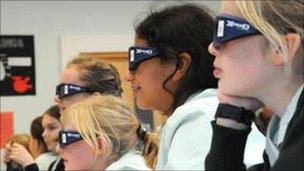3D learning tools positive for pupils, says study
- Published
Biology teacher Ros Johnson says 3D projections of body organs have given lessons a new direction at the Abbey School in Reading.
A study of the impact of 3D in the classroom has found that it improves test results by an average of 17%.
Increasingly schools are using 3D projectors and learning resources to add a new dimension to learning.
The research, conducted in seven schools across Europe, found that 3D-enabled learning tools helped children concentrate more.
It also led shy children to speak up in class discussions.
Only a handful of schools in the UK use the technology, which requires a 3D-enabled projector as well as 3D glasses for all pupils and a set of bespoke learning resources.

3D provides a wow factor in class but it has longer lasting effects, research says
The study, conducted by researchers from the International Research Agency on behalf of Texas Instruments, assessed 740 students in schools across France, Germany, Italy, Netherlands, Turkey, the UK and Sweden.
Students were tested before and after the lessons with a control group learning with traditional resources only.
On average, 86% of pupils in 3D classrooms improved in test results, compared to 52% of children using traditional teaching methods.
It also found that attention levels soared - with 92% of the class paying attention during 3D lessons compared to 46% in the traditional learning environment.
"It grabbed children's attention and this carried on beyond the 3D episode, it seemed to trigger an interest in learning that maintained through the rest of the lesson," said Prof Anne Bamford, who led the study.
"The level of questioning also increased and anecdotally teachers reported that the children asking questions were those that wouldn't normally engage in class," she told the BBC.
Researchers observed a series of biology lessons, in which children learned about the functions of the body.
"Children can see how things function. Instead of learning about the heart statically they can see it in a solid way, literally see blood passing through the valves, see exchange of oxygen, rotate it, tilt it and zoom in," said Prof Bamford.
- Published27 December 2010
- Published27 September 2011
- Published21 September 2011